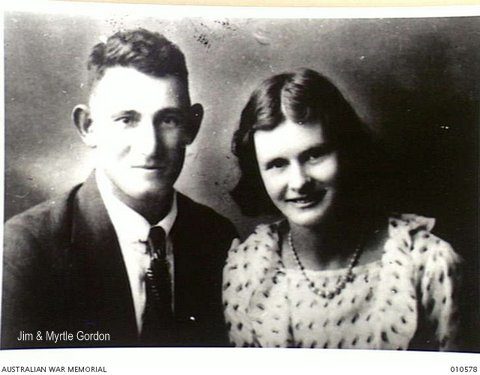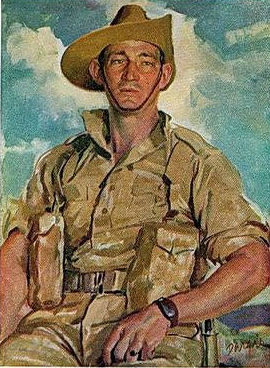Pte James Heather Gordon won the VC in an action that took place on 9th July 1941
against the Vichy French troops just north of the town of Djezzine in Syria. The following is an account written by Brigadier Amies CBE who was adjutant of 2/31Bn at the time that Jimmy Gordon won his VC. It is drawn from the book “Crossed Boomerangs” a history of the 31 Battalions written by the late Bob Burla.
D Coy, 2/31Bn was given the task of capturing a prominent tree covered hill known for the operation as “Green Hill” which dominated the left flank of the Battalion and commanded the one and only road leading North. The enemy was known to be occupying the position in force, with heavy weapons of all types.
To assist D Coy in its task a troop of light tanks and the battalion’s carrier platoon were to advance and attack the enemy’s right flank simultaneously.
The terrain was the toughest imaginable. No previous reconnaissance of any length had been possible. A precipitous wadi 800 feet deep separated D Coy from the objective, which rose another 600 feet on the far side of the wadi in a series of stony terraces four or five feet high every twenty yards or so. To scramble up the hill at any time, let alone having to fight one’s way up at the same time, was no mean feat. It was another instance of the particularly hard going that had faced the battalion ever since it crossed the Syrian frontier thirty three days before.
The company skirted the wadi and attacked from the south east at zero. It was not long before it became apparent that the Battalion was once again up against a fierce, well diciplined foe who would contest every step of the way, and not just hand his line over to the attackers – as had sometimes been stated in press accounts of this campaign.
The attack developed and soon D Coy was fully committed, indeed up against it. To make matters worse the engineers were unable to reconstruct in time , a bridge that the enemy had blown. The bridge spanned a deep wadi which traversed the one and only tank approach. The tanks and carriers were unable to cross as expected. Their crews dismounted and gallantly endeavoured to carry out their role on foot, but naturally made little progress.
Pte Gordon was in the leading platoon of D Coy. When the expected pressure on the enemy flank by tank and carriers did not eventuate, D Coy were faced with staying where they were or going on alone. They went on and very soon found that they were up against superior numbers and a well-laid out fire plan. This did not deter them and the company followed the artillery barrage right up to the last, actually penetrating the enemy’s line.
It was almost dawn and the moonlight was giving way to the first light of day. Gordon and his platoon were pinned down, as were the remaining two platoons, by heavy machine gun fire. Casualties had been heavy, and the platoon commander, Lt Malcolm Davis, realized the urgency of either pushing on or giving up and withdrawing. He decided to endeavour to continue, as the platoon was within sight of its objective. To remain where they were would only court disaster in the long run. Davis died whilst gamely endeavouring to lead his platoon forward and Sgt Birchall took command. Each time any man moved either forward or backward, or to test either flank, he became a casualty. The situation was desparate, and the full light of day would soon bring further disaster. There was but one thing to do – silence the enemy machine gun post.
Gordon had been lying there amongst the dead and dying, when one of his mates heard him say quite calmly, “Blast this, here goes”, and on his own initiative, and with great daring, he commenced to crawl towards that deadly machine gun. He knew only too well what he was up against, the terrible risk he was facing, and that death would be his lot, too, if he failed.
In the pale eerie light of a setting moon and the first light of day, made all the more eerie by the smoke and dust of battle, he slowly but surely reduced the distance between himself and that murderous enemy post. His only weapon was his rifle, affixed to which was the cold steel of his deadly bayonet. He wormed his way up the rocky hillside, his only protection being small scattered boulders and an occasional crumbling terrace or two. The enemy saw him approaching and fired upon him. They also threw hand grenades at the crouching figure, but Gordon seemed to bear a charmed life.
The attention of the survivors of the platoon was drawn to the display of cool courage and determination by their comrade, when suddenly one of them watching Gordon called out in frank admiration, “Gosh, look at Jimmy Gordon!”
There within fifteen feet of the fortified enemy position was Pte Gordon, and inspired by some great call to give nothing but the best, he suddenly rose from his scanty cover and, with a yell, single handed, charged the deadly machine gun. The sight of this suntanned and grim specimen of Australian manhood coming straight at them with cold steel and a blood curdling yell, completely demoralized the enemy. Before they could fire again he was amongst them with his rifle firmly held before him and his bayonet doing the deadly work for which it was designed. Not once did he falter as bayonet and rifle worked swiftly and surely until the four machine gunners lay dead at his feet.
The survivors of the platoon, though temporarily spellbound with admiration were quick to take advantage of their comrade’s gallant action. They rose as one to press home the attack. Throughout, Gordon remained well to the fore, his bayonet taking toll every second. The enemy became demoralized to find the Aussies so close and unexpectedly amongst them, and it was not long before the remainder of D Coy joined the assault and the objective was taken.
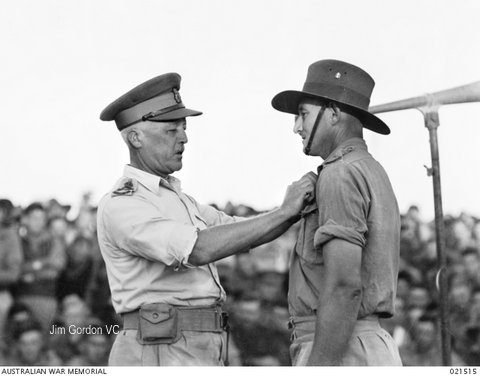
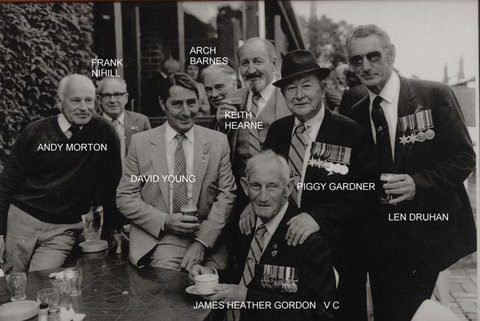
Jim Gordon VC at a Reunion of 2/31 Bn members shortly before he passed away.
As a footnote to the above graphic description, Jimmy Gordon was to see further action closer to home in the jungles of New Guinea. After the Syrian Campaign he returned to Australia with his unit and was sent to New Guinea where as Cpl, and Sgt he took part in the fighting in the Ramu and Markham Valley and Lae campaigns.
After the war he returned to Australia to settle in West Australia with his wife Myrtle. He went on to rejoin the Army being promoted to WO11 in 1950.
When the 31st Battalion battalion was based at Jezzine Barracks in Townsville, Queensland, the Jezzine weekend was commemorated each year in July with various military activities and displays. When the unit celebrated its 100th anniversary in 1985, the organizing committee had hoped that arrangements could be made for Jimmy Gordon to fly to Townsville to participte in the centenary occasion. Unfortunately due to failing health he was unable to attend. He passed away in 19 July1986. He was survived by his wife Myrtle and a son.
Lest We Forget.
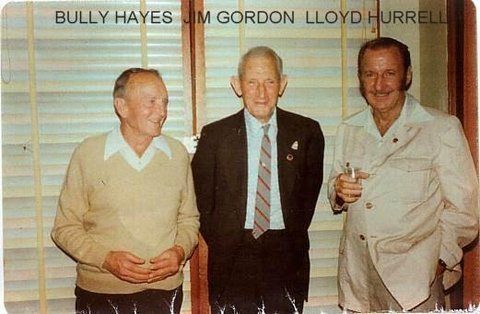
Jim Gordon VC with a couple of old mates
